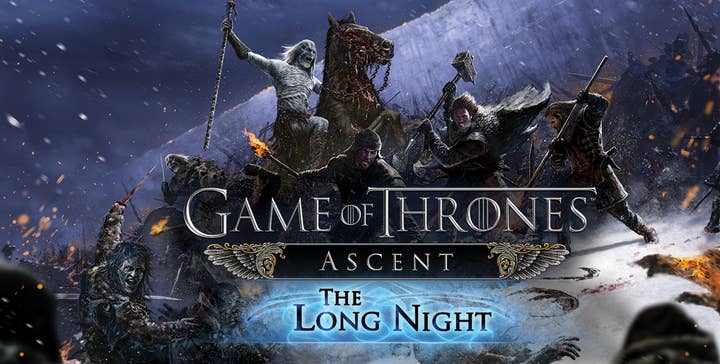The Long Tail of Mobile Games
Disruptor Beam's Jon Radoff warns that too many companies squander long-term gain by maximizing revenues upfront
In today's mobile game market there are a couple ways that most companies look at user acquisition and retention. What it really comes down to is which audience they are focused on more - short-term or long-term customers. Some companies have a primary focus on advertising-based acquisition channels, such as Zynga or Glu Mobile. Companies like these often strive to maximize revenue from those who just downloaded a game, or short-term customers. On the other hand, there are companies that focus more on retaining and monetizing customers who are likely to stick around for weeks and often months, or long-term customers. Both approaches can be successful. For Disruptor Beam and for Game of Thrones Ascent, we've taken the latter approach and have optimized our business for the long tail. I'd like to talk more about that here.
From our perspective, the companies that are maximizing short-term revenue often do so at the expense of the entire long tail. Because that is what an advertising-centric user acquisition program usually forces upon you. In fact, this is a trap that many dot-com companies outside of games have fallen into. They've adopted a lifetime-focused model of customer acquisition, get enormous pressure to raise tens of millions of dollars, and then spend it all on advertising, abandoning the original lifetime value model. The more you spend on customer acquisition, typically, the less valuable your customers end up being. And when you've acquired a large amount of lower value customers it can be a dangerous place to be in.
So, we at Disruptor Beam allocate more of our resources towards nurturing long-term relationships with customers vs. advertising-based customer acquisition. Now, that is not to say that we don't do any advertising. We do. But, advertising is really to address a segment of customers that are secondary to us. We've found that those customers that stick around (15+ sessions in the first 14 days of play), even if the pool of them are smaller, are more profitable for us and more valuable to our overall community.
The Analytics of the Long Tail
Our approach to analytics has actually changed somewhat since we first launched Game of Thrones Ascent. We've moved away from primarily looking at D1 retention and instead look at the overall value of an account. The fact of the matter is that the people who have paid in the past are more likely to pay in the future. And, unfortunately, the mobile and social games market is one in which not many people pay. For even a super successful game 95% of the people who enter the top of that funnel will never pay anything.
"If you overemphasize the early revenue potential of any given customer, you often times alienate customers that have been more valuable to you over the long term"
Since launch, we knew that our D1 retention was not as strong as more casual products like Farmville-esque games. At the same time, we noticed that our early monetization was strong, and people who liked our product really liked it. We saw this even as soon as we soft-launched the game back in February 2013. Therefore, we decided to focus more on longer-term engagement. It's also worth noting that we didn't necessarily scale back any features in this process. Instead, these findings guided our strategy regarding where we should continue to invest our time and resources design-wise. More on that below.
We see that the way many companies approach experiment driven iterative improvement is troubled by the fact that they have a long list of improvements - D1, D3, D7, conversion, CTR, revenue, etc. You could go through the list and a lot of these metrics may not even actually matter. Conventional wisdom in mobile games is to optimize for D1 retention, then for conversion, then for maximizing revenue out of those conversions. The problem here is that this sequence of data produces just one particular type of game - one that has mass-market appeal, but that may be superficial and something a person only wants to engage with for two days vs. two years.
It brings a lot of clarity to the development effort when you can identify the one (or maybe two) metrics that actually do matter. For us, it is lifetime value of accounts and the percentage of paying accounts that we maintain long term. We're more concerned with a player's 3, 6, 12 month retention compared to their 1, 2, 3 day retention. That is not to say that D1 retention is unimportant, but rather that we're focused more on the long tail.
If you look at our active population for Game of Thrones Ascent, about a quarter of our customers pay once they are active (at least 10 sessions in the game). This is an extraordinary number. We've also actually gotten to a point with Game of Thrones Ascent that when a player becomes a paying customer, they are often times active for a long period of time after that session - sometimes for even a year or more. In fact, over 50% of our players (across platforms) return to continue playing the game actively after making their first in-game purchase.
There are a number of different varieties of games, besides strategy RPGs (like Game of Thrones Ascent) that also do well with this high-LTV / low D1 model. Those are primarily card battlers, like Hearthstone, and resource wargames, like Puzzle & Dragons / Clash of Clans.
Impact on Game Design
With an approach that has been less capital-intensive surrounding acquisition, our dollars are not going to advertising programs that we have to cycle back super quickly. This ultimately impacts how we think about game design. Why? Because if you're concerned most about accelerating revenue to the front end of the customer relationship, you're usually not thinking as much about how your game design will impact those long term customers. If you overemphasize the early revenue potential of any given customer, you often times alienate customers that have been more valuable to you over the long term.

A great example of how our design has been adapted to those long-term players is by looking at our Alliance system in Game of Thrones Ascent. When the game first launched, Alliances were not really anything other than a chat channel (which is what they are in most MMOs). But early on we observed that if people were in Alliances, they were more likely to become paying customers. We always suspected that that was the case. The conclusion we drew was that we needed to add more stuff for alliances to do. We've since added Alliances vs. Alliances, a world event system, and more. Now we have players that are so deeply engaged in Alliances that they are forming outside relationships after meeting in-game. We also have a number of Alliances that have organized their own mini-tournaments in-game that go even beyond our own Alliance vs. Alliance system. We're dedicating resources to fostering these types of activities, ones that cater to those long-term players. We've doubled down on community. And, so far, it's working.
Another example worth noting is changes we've made to our Sworn Swords. We've added tools that make it easier for players to manage large numbers of in-game characters (what we call Sworn Swords) to send on quests and earn currency and reward items, as a result. This has allowed players to accomplish more in the amount of time in which they played and, in turn, attracted them to longer-term play.
"If you are in the business of creating a small, focused group of games, plan to sustain your audience for the long term. Otherwise you won't be able to survive between game releases"
In addition to in-game systems like Alliances, we've also geared our content releases to long-term players. We release new game content every single week both while the TV show is on the air and while it is off-air. This allows us to re-engage long-term players very regularly. We've also started to release regular expansions off-season, such as our recent The Long Night expansion. Additionally, the fact that we are now cross-platform has helped us engage players more deeply, giving players the opportunity to play not just on one device, but many.
Pick a Side
In conclusion, there are the mobile game companies that make a high volume of games and churn through them rapidly with a focus on short-term customers and ad-based user acquisition. Then there are the companies that focus on creating a smaller quantity of games and instead cater design towards long-term customers. We're in that camp.
Our advice to other companies? Know which business you are in. And, once you know that, fine-tune your specific metrics for your business model and audience.
If you are in the business of creating a small, focused group of games, plan to sustain your audience for the long term. Otherwise you won't be able to survive between game releases. You have to adopt a lifetime value approach to metrics, in every sense. On the other hand, if you want to pump out lots of games, yield quickly on customer acquisition and advertising. We've found success in the former.
Jon Radoff is a serial entrepreneur and the CEO and Founder of Disruptor Beam, a game company hyper-focused on community.
